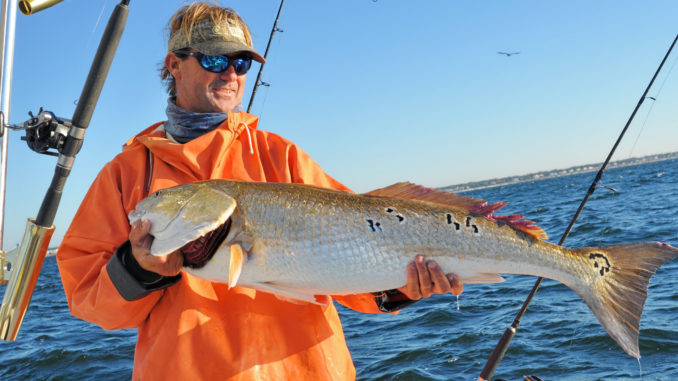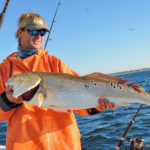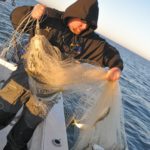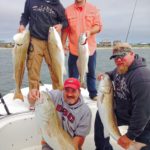
Find big balls of menhaden in shallow water off the beach and you’ll likely have a chance to battle a bull red.
Saltwater fishermen know that July and August are the best months to chase the big spawning channel bass known as “old” red drum in Pamlico Sound.
By September, many of these fish, which can weigh as much as 60 pounds, move through inlets back into to the Atlantic Ocean as cool nights trigger outbound baitfish migrations.
These magnum-size fish head south once they clear the inlets, appearing in the surf and causing thousands of fishermen to descend on beaches with 11-foot “Hatteras Heaver” rods in hand to sling huge strips of mullet a hundred yards out into the surf.
Until two years ago, only a few anglers knew big schools of drum followed baitfish around Cape Fear’s shoals to gorge on menhaden in shallow water off Brunswick County’s beaches all the way to South Carolina.
Kevin Sneed, a fishing guide from Holden Beach, discovered three years ago that he could find bull reds in relatively shallow water off his home beaches.
“A friend of mine, Nesbitt Noble, who works at The Tackle Box in Southport, told me,” said Sneed, who traces his friendship with Noble back to their toddler years, when their families traveled to the area for vacations.
Anglers knew old drum showed up in the fall, but the encounters were nearly always in deeper water around the Yaupon and McGlammery reefs in nearshore waters, and almost always accidental during trips for king mackerel, flounder or bottomfish.
Then came the fall of 2013.
“Nesbitt told me about fishing for big reds underneath bait balls just off the beaches,” Sneed said.
At first, Sneed and his friends used the same tackle they employed for smaller, inside-waters reds, but it took too long to land the 30- to 50-pound fish on relatively light tackle, stressing the old drum too much.
“We learned pretty soon we needed heavier rods, reels and line to get fish to the boat and release them quick,” he said. “We used the same rods, reels and lines we used for sharks to cobia.”
Sneed now favors 6-foot-6, medium-heavy, medium-fast action Shimano rods mated to Penn Battle 7000 or 8000 Series spinning reels spooled with 60-pound braid. Terminal tackle is a Carolina rig with an 80-pound fluorocarbon leader 18 to 24 inches long, a 2- or 3-ounce barrel sinker and a snelled 7/0 circle or Octopus hook.
“You can turn an old drum’s head and reel him in pretty fast with this,” Sneed said. “We couldn’t keep them anyway because most are longer than the (18- to 27-inch) slot. It’s all catch-and-release fishing. We’d get a fish to the boat, net it, take some pictures and release it.”
Red drum are strong and durable, so shorter battles on heavier tackle are effective at getting fish back in the water alive and well.
“You support a redfish underneath his head with one hand, grab in front of his tail with the other hand, point him toward the water, then drop him straight down, headfirst, like launching a torpedo,” Sneed said. “The head-first drop forces water through his gills and revives him.”
For bait, Sneed prefers large fall menhaden, but pinfish also work.
“Usually, the water’s so full of (menhaden), it takes just one or two cast net throws to get all you need,” Sneed said. “You ease up to a school, throw the net, let it go to the bottom, then jerk the hand line to close the bottom.”
The key to finding baitfish is diving birds or seeing bait flip on the surface, he said. Best fishing occurs on a north to northeast wind. The Brunswick County beaches run east to west, so a north to northeast wind creates a fairly smooth ocean and clear water.
“I like a strong north wind because water conditions will be calm,” Sneed said. “The harder it blows from the north, the better they bite.”
After netting baits at dawn, Sneed begins looking for red drum signs.
“You cruise the beaches and watch for birds, then you want to see pogeys in a tight ball, flipping on top,” Sneed said. “But the best situation is to see mud stirred up. That means drum are underneath them. The muddy water is caused by the drum pushing (menhaden) up (to the surface) like sailfish. It makes the mud boil up.”
Sneed often finds feeding redfish from the surf to a half-mile off the beach because the water may be only 8 to 10 feet deep that close to the shore.
After finding a mud cloud, he hooks a baitfish through the nostrils from beneath its jaw and casts to the melee.
“There’s a trick I use,” he said. “I use a pair of scissors to cut off a baitfish’s tail. That puts blood in the water and makes pogeys really wiggle. The drum hone in on the blood.”
Usually, Sneed permits two anglers at a time to fish while he maneuvers the boat. Too many drum hooked at the same time creates difficulties in guiding the boat to land fish.
“But one time, just for fun, we had ideal conditions and put out five baits, hooked five drum and landed and released all of them,” he said.
Sneed said the redfish bite will vary.
“On a bad day, you might only catch four or five fish in a four-hour period,” he said. “A good day you might catch 20 to 25; they may vary from 20 to 40 to 50 pounds.”
When the bite ends at one spot, Sneed looks for more birds or a different mud boil, then he and his clients begin fishing again.
If the inshore bite doesn’t happen, he’ll head for a nearby reef. If drum and baitfish aren’t on the beach, he’ll return to Lockwood Folly River to throw a cast net to land finger mullets for bait.
“I’ll also use a Sabiki rig to jig up pinfish for bait,” he said. “I’ve been at Yaupon reef 1 ½ miles off the beach with wind from the northeast, and you couldn’t keep a bait in the water.”
Sneed knows about the popping-cork technique used to catch old drum in the Pamlico Sound, and he may try it out this fall.
“I haven’t tried that yet, but I think I will at some point to see if it’ll work in the ocean,” he said.
This fall, however, following his experiences the past two years using live baits to land ocean bull reds, he may be reluctant to fix something that isn’t broken.
DESTINATION INFORMATION
HOW TO GET THERE — To reach Holden Beach, take US 17 west from Wilmington and NC 130 south to Holden Beach. From the Piedmont, take NC 87 south to Elizabethtown, then NC 701 south to Clarkton and NC 211 east to US 17 to NC 130. From Charlotte, take US 74/76 east to NC 211 and NC 130.
WHEN TO GO — Mid-September through October are prime times to do battle with an old drum off the beaches of Brunswick County.
BEST TECHNIQUES — With a livewell full of menhaden, cruise the beaches in 8 to 10 feet of water and watch for diving birds and menhaden flipping on the surface and mud boils indicating feeding red drum. Cut tails off menhaden baits and hook them through the nose with 7/0 circle or octopus hooks as part of Carolina rigs with 2- to 3-ounce weights and 18 to 24 inches of 80-pound fluorocarbon leader and 60-pound braid on the reel. Medium-heavy rods are the norm.
FISHING INFO/GUIDES — Kevin Sneed, Rigged & Ready Charters, 910-448-3474, www.holdenbeachcharter.com; Mark Stacy, Ocean Isle Fishing Charters, 910-279-0119, www.oceanislefishingcharters.com; Mark Dickson, Shallow-Minded Fishing Charters, 843-458-3055, www.fishmyrtlebeach.com; The Tackle Box, Southport 866-395-3474. Also see Guides & Charters in Classifieds.
ACCOMMODATIONS — Gray Gull Motel, Supply, 910-842-6775; Brunswick County Chamber of Commerce, Shallotte, 910-754-6644, www.brunswickcountychamber.org; Southport/Oak Island Area Chamber of Commerce, 910-457-6964, www.southport-oakisland.com.
MAPS — Sealake Fishing Guides, 800-411-0185, http://www.thegoodspots.com; Capt Segull’s Nautical Charts, 888-473-4855, www.captainsegullcharts.com; GMCO’s Chartbook of North Carolina, 888-420-6277 www.gmcomaps.com.






